 Image search results - "year's" Image search results - "year's" |
|
|
|
|
|

Sign reads, "Hatsumode" or New Year's worship.
|
|

The first torii to the shrine.
|
|

For the Year of the Rabbit.
|
|
|

Pretty crowded, but it proceeded smoothly.
|
|
|
|
|
|
|
|
|

From here, we had to wait in line.
|
|

The second torii.
|
|

Banners read Inaba Shrine.
|
|
|

Arched bridge too steep to cross over.
|
|
|
|
|

Inaba Shrine's taiko bridge. 神橋
|
|
|
|
|

We had to wait a while...
|
|
|

Romon Gate 楼門
|
|

View from Romon Gate.
|
|
|

The line proceeded fast enough.
|
|

Approaching another gate called Shinmon. 神門
|
|

View of Romon Gate from Shinmon Gate.
|
|

Inaba Shrine's Haiden Hall was where we could pray.
|
|

Lining up to pray at Haiden Hall.
|
|
|

Inside Inaba Shrine's Haiden Hall.
|
|

Offertory box
|
|
|
|

People buying good luck charms.
|
|
|
|
|
|
|
|
|
|
|
|
|
|

Inaba Shrine has a few other lesser shrines.
|
|
|
|

黒龍社
|
|

Romon Gate side view.
|
|
|
|
|
|

Inari Shrine torii. 楓稲荷神社
|
|
|
|
|

My video of Ise Jingu Naiku on Jan. 1, 2013.
|
|
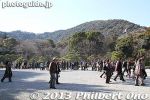
Where the people coming and going converge at Ise Jingu's Naiku.
|
|
|

Uji Bridge on the way back.
|
|

Isuzu River as seen from Uji Bridge. Water from this river is used in the shrine's ceremonies and rituals.
|
|

Crossing Uji Bridge on the way back.
|
|

Uji Bridge showing its 20-year age.
|
|
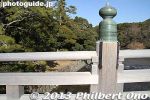
Uji Bridge is made of hinoki cypress wood. The bridge columns are made of keyaki.
|
|

Map of Naiku at Ise Jingu Shrine and adjacent area.
|
|

Right outside the entrance Naiku is a long shopping street called Oharai-machi, mainly food stalls. it leads to a parking lot. Very crowded on New Year's Day.
|
|

Dried fish.
|
|
|
|

Lucky bags.
|
|

Oharai-machi shopping street outside Naiku entrance. Bus stop for the train stations and Geku is near here.
|
|

Sando path from Ise-shi Station to Ise Jingu Shrine's Geku Outer Shrine. A short walk. You're supposed to visit Geku before Naiku.
|
|

I noticed that Geku was much less crowded than Naiku and apparently most people visit Naiku only. Lantern along the path to Geku.
|
|

Old ryokan inn.
|
|

Ise manhole depicting Ise Jingu pilgrims. Mie Pref.
|
|

Ise Tourist Information across from the Geku entrance. Very helpful.
|
|

Geku is Ise Jingu's Outer Shrine (officially named "Toyouke Daijingu"). It is one of the two main shrines of Ise Jingu. Geku worships the god Toyouke Omikami, who is responsible for the food of Amaterasu Omikami worshipped at Naiku.
|
|

Geku entrance. Toyouke Omikami is also the god for food, clothing, and shelter. Geku was founded about 1,500 years ago.
|
|

Path to Geku. 第一鳥居口参道
|
|

Water fountain where you wash your hands and rinse your mouth for purification. 手水舎
|
|

Before praying at the shrine, you're supposed to purify yourself. Wash your hands and rinse your mouth here. Use the ladle to pour water into your hand, then sip the water from your hand. Don't sip the water directly from the ladle. 手水舎
|
|

The first or Daiichi torii gate.
|
|

Sando path to Geku.
|
|
|
|
|

Shrine gift shop for amulets etc. Make no doubt, religion in Japan is very big business. They are in the business of selling hopes, dreams, prayers, ceremonies, and amulets.
|
|

The great thing for them is that they need not provide any guarantee that your hopes, dreams, and prayers will come true for you. No such thing as a product warranty nor money-back guarantee.
|
|

A sip of sake at this booth.
|
|

Amulets forsale.
|
|

Geku Outer Shrine at Ise Jingu.
|
|
|
|
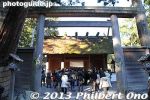
Entering Geku shrine at Ise.
|
|

Look how small the offertory box is at Geku.
|
|
|
|

Geku Outer Shrine
|
|

The new Geku Outer Shrine to be unveiled in Oct. 2013.
|
|

The shrine is rebuilt every 20 years and 2013 will mark the completion of the new shrine to replace the old one built in 1993. It takes 8 years to rebuild the Naiku shrine. So 12 years from now, they will start the rebuilding process all over again.
|
|
|
|
|

Collecting coins.
|
|

Adjacent pond.
|
|

After praying at Geku, most people also visit three nearby affiliate shrines: Kaze-no-miya, Tsuchi-no-miya, and Taka-no-miya. This is Kaze-no-miya Shrine. 風宮
|
|
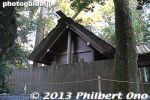
Kaze-no-miya Shrine 風宮
|
|

Kaze-no-miya Shrine 風宮
|
|

Kaze-no-miya Shrine is dedicated to the gods of wind and rain, essential for farming. 風宮
|
|

Tsuchi-no-miya Shrine worships the god in charge of the land around Geku. 土宮
|
|

Tsuchi-no-miya Shrine 土宮
|
|

Tsuchi-no-miya Shrine 土宮
|
|

Taka-no-miya Shrine 多賀宮
|
|

Long line to pray at Taka-no-miya Shrine. "Taka" literally means "many felicitations." 多賀宮
|
|
|
|

Taka-no-miya Shrine 多賀宮
|
|

Taka-no-miya Shrine 多賀宮
|
|

Collecting coins at Taka-no-miya Shrine 多賀宮.
|
|

Collecting coins at Taka-no-miya Shrine 多賀宮.
|
|

Taka-no-miya Shrine, old and new. 多賀宮.
|
|
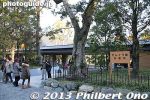
A new museum called Sengu-kan to commemorate the shrine's rebuilding for the 62nd time (since over 1,200 years ago).
|
|

Sengu-kan Museum includes a scale model of the Geku shrine as well as a life-size facade of the main shrine building. Don't miss this museum.
|
|

Outdoor stage at Sengu-kan.
|
|

Magatama Pond next to Sengu-kan.
|
|

Ise-shi Station. 伊勢市駅
|
|

White rocks to be placed at Ise Jingu Shrine for the rebulding.
|
|

They are renovating the space in front of Ise-shi Station.
|
|

Dance by shrine maidens on New Year's Day 2005 at Taga Taisha Shrine.. Also see the 2005 video at YouTube.
|
|
|
|
|
|